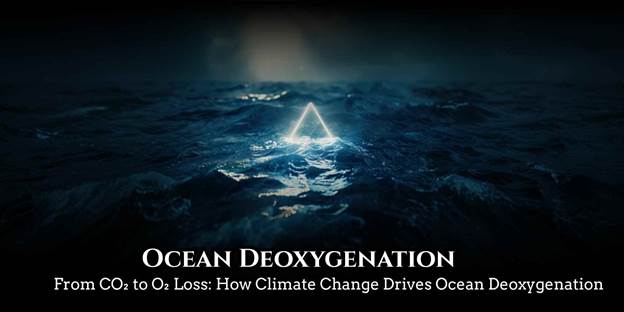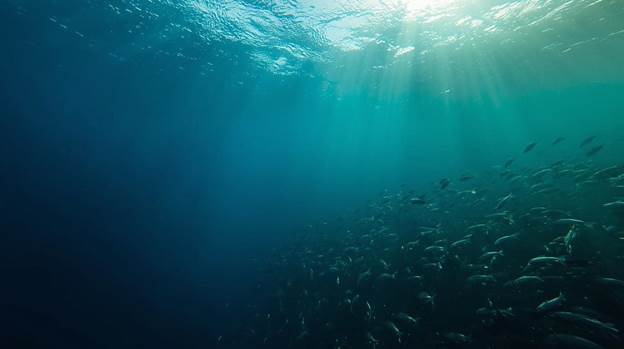Ocean deoxygenation is the process by which oxygen levels in the world’s oceans decline over time, primarily due to global warming and human-induced climate change. As the Earth warms, oceans absorb more carbon dioxide (CO2), altering their chemistry and reducing oxygen availability for marine organisms. The relationship between CO2 buildup and O2 loss has become one of the most concerning developments in Earth’s climate system.
Table of Contents
This article explores the causes, mechanisms, and far-reaching consequences of ocean deoxygenation, examining how rising greenhouse gases, warming waters, and disrupted ocean circulation are driving this silent but significant transformation.

What Is Ocean Deoxygenation? A Brief Definition
Ocean deoxygenation refers to the gradual reduction of dissolved oxygen in marine environments. This decline affects the ability of marine organisms to survive and reproduce, influencing the stability of entire ecosystems. The primary driver behind this process is climate change, which warms ocean waters, reducing oxygen solubility and altering ocean circulation patterns.
In the natural state, oceans maintain a balance between oxygen produced by photosynthetic plankton and oxygen consumed through respiration and decay.
Historical Background: When Did Ocean Deoxygenation Begin?
Scientists have traced signs of ocean deoxygenation back to the mid-20th century. As industrial activity expanded, CO2 concentrations in the atmosphere began to rise sharply. Oceans, acting as massive carbon sinks, absorbed roughly 25–30% of these emissions. However, this absorption came with a cost warming and acidification that began depleting oxygen levels.
Modern studies reveal that the ocean’s oxygen content has declined by around 2% since 1960, and the rate of loss continues to accelerate. Areas such as the eastern tropical Pacific and northern Indian Ocean are now experiencing rapid oxygen depletion, giving rise to vast “dead zones” where marine life struggles to survive.
How Climate Change Drives Ocean Deoxygenation
The link between CO2 emissions and oxygen loss is complex but deeply intertwined. Three main mechanisms explain how climate change accelerates ocean deoxygenation:
- Warming Reduces Oxygen Solubility
As water temperature increases, its ability to hold oxygen decreases. Warmer surface layers trap oxygen near the top, limiting its downward movement into deeper waters. - Stratification Blocks Oxygen Mixing
Climate-induced warming enhances stratification the formation of distinct layers in the ocean. This prevents oxygen-rich surface waters from mixing with deeper layers, creating hypoxic (low-oxygen) zones. - Increased Metabolic Demand
Warmer temperatures increase the metabolic rate of marine organisms, meaning they consume oxygen faster while less of it is available. This double effect leads to oxygen stress and biodiversity loss.
The Role of Carbon Dioxide in Ocean Chemistry
CO2 not only contributes to global warming but also alters ocean chemistry through acidification. When CO2 dissolves in seawater, it forms carbonic acid, lowering the pH of the ocean. This acidic environment affects plankton, corals, and other organisms that play key roles in oxygen production and nutrient cycling.
Over time, acidification weakens the ocean’s biological pump a system that transfers carbon from surface waters to the deep sea further reducing oxygen renewal. This means that the more CO2 we release, the less O2 the ocean can sustain, creating a self-reinforcing feedback loop.
Consequences of Ocean Deoxygenation on Marine Life
The biological impact of oxygen loss is severe and far-reaching. Marine species that depend on oxygen-rich environments, such as tuna, cod, and marlin, are forced to migrate to shallower waters, increasing competition and disrupting ecosystems.
Key impacts include:
•The spread of oxygen-depleted “dead zones” where marine life struggles to survive
• Decline in fishery productivity and food security for coastal communities
• Coral reef degradation due to combined stress from warming, acidification, and oxygen loss
• Altered migration patterns affecting global biodiversity
In regions like the Arabian Sea and the Gulf of Mexico, seasonal hypoxia now threatens major fisheries and local economies, underscoring the real-world consequences of this phenomenon.
Case Studies: Real-World Evidence of Ocean Deoxygenation
1. The Gulf of Oman:
This region has one of the largest and most severe oxygen minimum zones (OMZs) in the world. Satellite and sonar data reveal vast expanses of nearly oxygen-free water, driven by warming and nutrient pollution.
2. The Eastern Tropical Pacific:
This area has shown significant oxygen loss over the last few decades, affecting migratory species and shifting entire food webs.
3. The Baltic Sea:
Known for recurring “dead zones,” the Baltic is a prime example of how eutrophication and climate change interact to deplete oxygen, leading to major fish population declines.

Mitigation Strategies: Can We Reverse Ocean Deoxygenation?
While reversing oxygen loss completely may not be possible in the short term, effective measures can slow its progression:
• Reducing greenhouse gas emissions to limit global warming and ocean heating
• Controlling nutrient runoff from agriculture to prevent excessive algal blooms
• Protecting coastal ecosystems like mangroves and seagrasses, which act as natural oxygen generators
• Enhancing monitoring systems to track oxygen changes and predict future impacts
The Future of Oceans: A Call for Urgent Action
If current trends continue, scientists predict that ocean deoxygenation could expand by 20% or more by the end of the century. This would threaten marine biodiversity, food chains, and even global climate regulation. The ocean’s ability to absorb CO2 and produce oxygen is vital for sustaining life both below and above the surface.
Protecting this balance requires immediate global cooperation, strong emission reduction policies, and the restoration of critical marine habitats.
Conclusion
Ocean deoxygenation represents one of the most pressing yet under-recognized consequences of climate change. From CO2 buildup to O2 loss, the ocean’s silent struggle reflects humanity’s impact on Earth’s life-support systems. By understanding and addressing the causes behind this crisis, we can help preserve the delicate oxygen balance that supports marine life and stabilizes our planet’s climate.